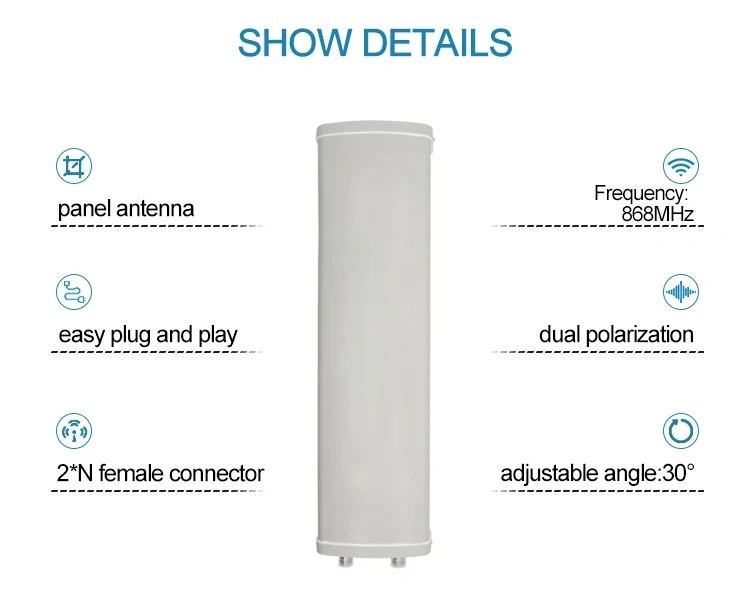Basic Info.
Model NO.
VP-3516-16
Base Antenna
High Gain Antenna
Nature of Operation
Transmitting Antenna
Sturcture Form
Wire Antenna
Dimensionality
Two-Dimensional Antenna
Connector
N Type Female
Transport Package
Pulp Packing+Master Carton
Specification
360X160X85mm, 2.5KGS
Trademark
No
Origin
China
HS Code
8517710000
Production Capacity
5000PCS/Month
Product Description
1.7 GHz to 2.7 GHz 2-port sector Antenna, 16 dBi, 45-degree, 2 x Type N Female connector, H/V Dual Pol
Frequency Range: 1.7 GHz to 2.7 GHz
Polarization Type: 45 Deg. Slant
Gain: 16 dBi
Vertical Beamwidth: 14°
Horizontal Beamwidth: 32°
Electrical Downtilt: 1°
F/B Ratio: 28 dB
VSWR: 1.7:1
Cross Polar Ratio: 25 dB
Port Isolation: 25 dB
Connector Type: 2 x Type N Female
Description
The VP-3516-16 is a 2-port 16 dBi sector antenna designed for use in 2.7 GHz WiFi and LTE networks. The unique design of these 2.4 GHz sector antennas provides a true 120-degree beamwidth and ±45-degree slant dual polarization scheme. These antennas includes 2 x 36" N-Male to N-Male LMR 200 Cables and a mounting bracket for the Cambium PMP radios.
The VP-3516-16 sector antenna is designed to provide high-gain and maximum coverage and feature improved front-to-back and pattern roll off that allows for higher spectral efficiency. This sector antennas operates in the popular LTE and WiFi frequency range of 1.7 GHz to 3.8 GHz and delivers VSWR of 1.5:1 to 1.7:1 depending on frequency.
Features
2.4GHz dual polarized sector directional antenna
14.5 dBi gain , 120 degree beamwidth
Adapter on back designed for Cambium PMP radios
Type N female integrated connector
Heavy duty mounting brackets
Applications
2X2 MIMO ready
2.4 GHz applications supported
Wireless LAN systems & I25 802.16e applications
Mobile WiMAX Wireless Internet Provider cell site
Smart cities expansion for coverage and IOT / IIOT
Outdoor point-to-point (PtP) or point-to-multipoint (PtMP) applications








Frequency Range: 1.7 GHz to 2.7 GHz
Polarization Type: 45 Deg. Slant
Gain: 16 dBi
Vertical Beamwidth: 14°
Horizontal Beamwidth: 32°
Electrical Downtilt: 1°
F/B Ratio: 28 dB
VSWR: 1.7:1
Cross Polar Ratio: 25 dB
Port Isolation: 25 dB
Connector Type: 2 x Type N Female
| Electrical | |
| Frequency range(MHz) | 1700-2700 Mhz |
| Polarization | Horizontal/Vertical/±45° Slant |
| Gain | 16 dBi |
| Azimuth 3dB beamwidth | 32° |
| Elevation 3dB beamwidth | 14° |
| Electrical downtilt | 1° |
| V.S.W.R | ≤1.8 |
| F/B ratio | ≥28 dbi |
| Cross-pol ration | 25 dB |
| Port to port isolation | 25 dB |
| Input Power | 100 W max per port |
| Impedance | 50 Ω |
| Mechanical | |
| Connector Type | Type N Female x 2 |
| Dimension | 360x165x85mm |
| Weight (kg) | 2kgs |
| Mounting method | Pipe Mount |
| Mounting pole dia | 50mm-75mm |
| Surface Finish | Matt powder coat |
| Environmental | |
| Temperature range | -45° to 60°C/+140°F |
| Wind speed | 160 km/h / 100 mph |
| UV protection | UV resistant powder coat |
| Ingress protection | IP55 rain resistant |
Description
The VP-3516-16 is a 2-port 16 dBi sector antenna designed for use in 2.7 GHz WiFi and LTE networks. The unique design of these 2.4 GHz sector antennas provides a true 120-degree beamwidth and ±45-degree slant dual polarization scheme. These antennas includes 2 x 36" N-Male to N-Male LMR 200 Cables and a mounting bracket for the Cambium PMP radios.
The VP-3516-16 sector antenna is designed to provide high-gain and maximum coverage and feature improved front-to-back and pattern roll off that allows for higher spectral efficiency. This sector antennas operates in the popular LTE and WiFi frequency range of 1.7 GHz to 3.8 GHz and delivers VSWR of 1.5:1 to 1.7:1 depending on frequency.
Features
2.4GHz dual polarized sector directional antenna
14.5 dBi gain , 120 degree beamwidth
Adapter on back designed for Cambium PMP radios
Type N female integrated connector
Heavy duty mounting brackets
Applications
2X2 MIMO ready
2.4 GHz applications supported
Wireless LAN systems & I25 802.16e applications
Mobile WiMAX Wireless Internet Provider cell site
Smart cities expansion for coverage and IOT / IIOT
Outdoor point-to-point (PtP) or point-to-multipoint (PtMP) applications








